
Relics of the Old Post Office
(written by Megan Isely and Jenny DeRocher, Archives staff)
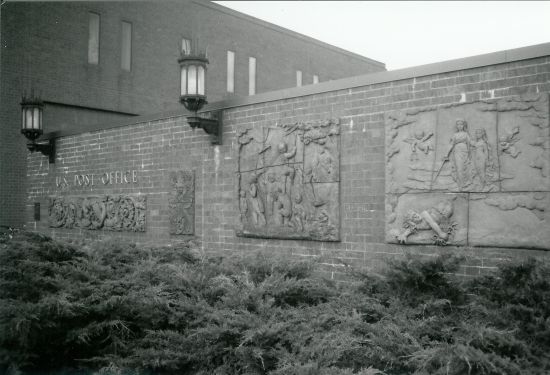
Commemorative wall featuring terra-cotta panels, lanterns, and U.S. POST OFFICE brass lettering from the Old Post Office building, 1978. Photo courtesy of architecture historian Dr. Les Crocker.
Near the entrance of the La Crosse Post Office, there is a series of terra cotta tiles on display. With no context or informative panel nearby, they seem to be mysterious relics of the past. Perhaps you’ve also noticed the old lanterns hanging above the tiles. These artifacts are among the only remaining materials left of the Old Post Office—which is more formally known as the Federal Building by local architecture historians. When the Old Post Office was proposed to be demolished in the 1970s, it divided many in the community. Even though the building was razed in the end, it did help activate a preservation movement in our community.
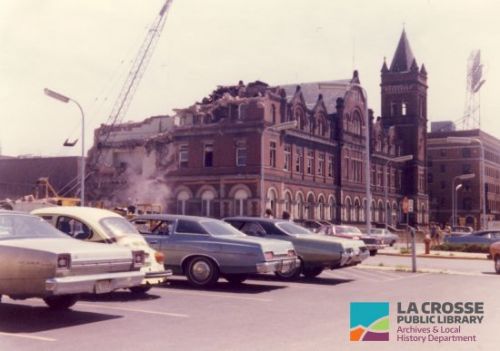
The Old Post Office was demolished in 1978.
The Federal Building was built in 1889 and by the 1970s, postal employees found the old building taxing. The heating and air conditioning system barely worked. Employees were issued tennis rackets to combat bats flying around the building. The nearly 90-year old building needed work and the Federal Government concluded it would be more beneficial to tear down and rebuild.
By the time locals realized that the Old Post Office was only one of three historic and beloved government buildings left in the city, it was too late to form a real resistance movement, though some tried. The summer before the building was going to be demolished, preservationists protested to protect the building. Counter protesters came out and argued that a new post office was a needed opportunity for jobs. In the end, there was more public support to bulldoze the old building.
To hear more about the 1970s protest, listen to this recorded story from one of the organizers, published with the Hear, Here project.
The wall displaying the relics near the entrance of the current building works to commemorate this story from all sides—the preservationists who wanted to save the old building as well as the construction workers who were able to save the relics, and even the postal workers who needed a bat-free environment to get their work done.

Commemorative wall was built in 1977 to display the terra-cotta panels, lanterns, and brass lettering. Photo courtesy of architecture historian Dr. Les Crocker.
The artifacts on display are decorations that had previously been part of the old building. The four lanterns were historically on the 4th St. entrance to the old building. The brass letters “U.S. POST OFFICE” were likely added during a 1931-33 addition that stretched the building further north down the block. The terra-cotta panels, however, were the most historically significant artifacts saved.
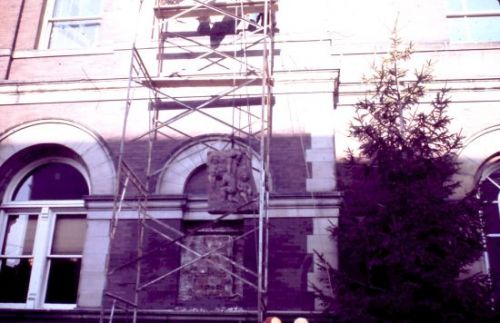
The terra-cotta panels were removed from the old building for preservation in 1977. Photo courtesy of architecture historian Dr. Les Crocker.
There are four panels, two of which were created from molds, and two that were hand crafted and are likely unique to our city. It is not known who the artist of these panels was, or who they were contracted from.

This wing of the Old Post Office was added in 1910. In the section of the photograph that is highlighted yellow, you can see one of the terra-cotta panels, which was about to be hidden by the addition for the next 60 years, until the building was set to be razed in the 1970s. Photo courtesy of the U.S. Postal Service.
They include a dragon-like creature (mold), a lion-headed chimera from Greek mythology (mold), child figures with mailbags (uniquely carved), and a figure symbolically showing experience protecting innocence (uniquely carved). This style of Roman and Greek art was common for public buildings build constructed in the U.S. in the late 1800s.
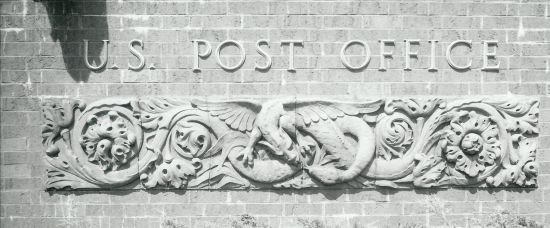
One of the two panels created from a mold, this panel features a dragon-like creature. Here it is displayed on the commemorative wall, 1978. Photo courtesy of architecture historian Dr. Les Crocker.
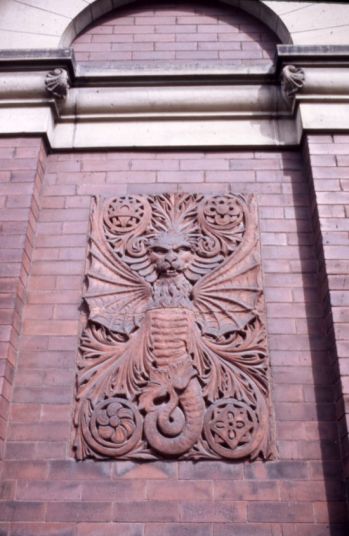
This panel depicts a lion-headed chimera from Greek mythology. It was the second panel that was created from a mold and was displayed on the Old Post Office under a stone arch that almost makes it look like it was part of the building, as you can see in this 1976 photo. Photo courtesy of architecture historian Dr. Les Crocker.
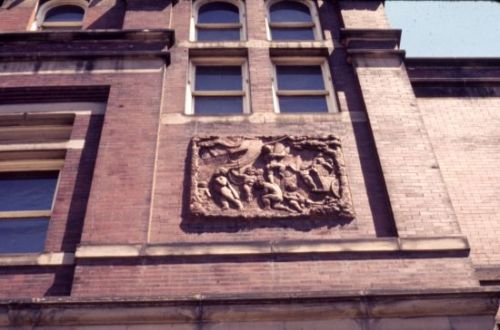
This panel was hand-carved, specifically to hang on the La Crosse Federal Building. It features child-like figures with mail bags. This 1976 photo shows how it was displayed on the State St. side of the old building. Photo courtesy of architecture historian Dr. Les Crocker.
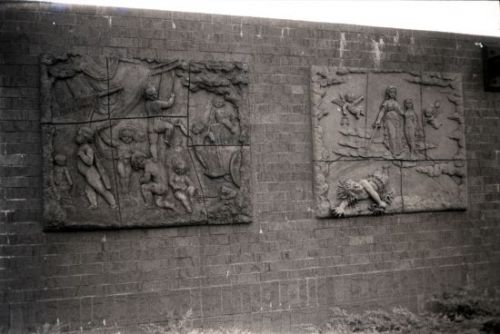
The last panel was also hand-carved and is unique to La Crosse. On the panel is a figure symbolically protecting innocence. You can see it on the right in this photograph, hanging on the commemorative wall. It is lighter in color than the mail panel on the left because it was hidden by the 1910 addition to the old building for over 60 years.
Though there is no informative panel explaining the significance of these pieces on the commemorative wall, these artifacts represent an important story in La Crosse history. Our local preservation movement fights to save our community’s cultural heritage so we can look at our built environment around us and ask how we got here today.
To learn more stories about our built environment and spaces in our community, contact the LPL Archives at (608) 789-7136 or by email at archives@lacrosselibrary.org. If you have materials you are interested in donating to the Archives or more information about the Old Post Office, please don’t hesitate to reach out.


